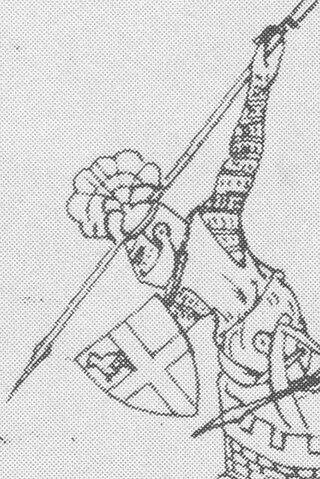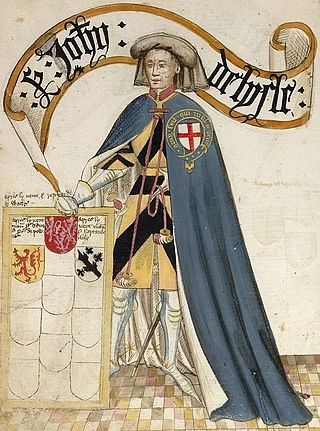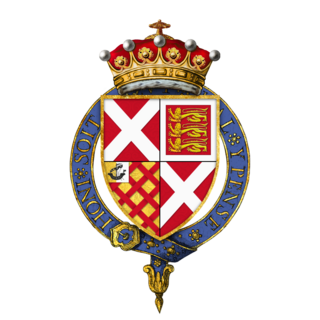Related Research Articles
Bartholomew de Badlesmere, 1st Baron Badlesmere was an English soldier, diplomat, member of parliament, landowner and nobleman. He was the son and heir of Sir Gunselm de Badlesmere and Joan FitzBernard. He fought in the English army both in France and Scotland during the later years of the reign of Edward I of England and the earlier part of the reign of Edward II of England. He was executed after participating in an unsuccessful rebellion led by Thomas, 2nd Earl of Lancaster.

Andrew Harclay, 1st Earl of Carlisle, alternatively Andreas de Harcla, was an important English military leader in the borderlands with Scotland during the reign of Edward II. Coming from a knightly family in Westmorland, he was appointed sheriff of Cumberland in 1311. He distinguished himself in the Scottish Wars, and in 1315 repulsed a siege on Carlisle Castle by Robert the Bruce. Shortly after this, he was taken captive by the Scots, and only released after a substantial ransom had been paid. His greatest achievement came in 1322, when he defeated the rebellious baron Thomas of Lancaster at the Battle of Boroughbridge on 16–17 March. For this he was created Earl of Carlisle.

Henry, 3rd Earl of Leicester and Lancaster was a grandson of King Henry III of England (1216–1272) and was one of the principals behind the deposition of King Edward II (1307–1327), his first cousin.

John de Warenne, 7th Earl of Surrey, was the last Warenne earl of Surrey.
Sir John de Benstede KB (c.1275 –1323/4) was a prominent member of the English royal household in the late 13th and early 14th century. He was Prebendary of Sandiacre from 3 February 1297 until, presumably, 1308, when he married. He was also King's Secretary, and he served variously as keeper of the Great Seal and controller of the wardrobe. He also served as Chancellor of the Exchequer from 1305 to 1306, and as a royal judge from 1309 onwards.
Ivo Taillebois was a powerful Norman nobleman, sheriff and tenant-in-chief in 11th-century England.
Christina Joyance Boughton was an English oboist and the daughter of composer Rutland Boughton and artist Christina Walshe. She died in 1963 in tragic circumstances..

John de Lisle, 2nd Baron Lisle of Rougemont, KG was an English peer and soldier who spent much of his career serving in the wars in France. He was a companion of Edward III, and one of the founding members of the Order of the Garter in 1348.

John Clifford, 7th Baron de Clifford, also known as John, Lord Clifford, 7th Lord of the Honor of Skipton, KG, was an English peer. He was killed at the siege of Meaux, France.

Ralph Neville, 4th Earl of WestmorlandKG, was an English peer and soldier. He was the grandson of Ralph Neville, 3rd Earl of Westmorland, and the father of Henry Neville, 5th Earl of Westmorland.
Sir Richard Redman was an English nobleman, knight, administrator and politician, being elected as a Member of Parliament representing Yorkshire and later acting as the Speaker of the House of Commons for the Parliament of 1415.

John Segrave, 2nd Baron Segrave was an English commander in the First War of Scottish Independence.

Sir James Strangeways was Speaker of the House of Commons of England between 1461–1462. and a close political ally of Edward IV's Yorkist faction.

Sir Bryan Stapleton KG was an English medieval knight from Yorkshire.
William de Aldeburgh, 1st Baron Aldeburgh was a 14th-century English nobleman and the builder of Harewood Castle.
Robert Waterton was a trusted servant of the House of Lancaster under three monarchs, Henry IV, Henry V, and Henry VI. As Constable of Pontefract Castle, he had custody of Richard II after that king was deposed.
Sir John Marmion, Baron Marmion of Winteringham was an Anglo-Norman baron who represented Lincolnshire in Parliament and fought in the Wars of Scottish Independence.
The Sheriff of Edinburgh was historically the royal official responsible for enforcing law and order and bringing criminals to justice in the shire of Edinburgh in Scotland. In 1482 the burgh of Edinburgh itself was given the right to appoint its own sheriff, and thereafter the sheriff of Edinburgh's authority applied in the area of Midlothian outside the city, whilst still being called the sheriff of Edinburgh. Prior to 1748 most sheriffdoms were held on a hereditary basis. From that date, following the Jacobite uprising of 1745, they were replaced by salaried sheriff-deputes, qualified advocates who were members of the Scottish Bar.
The Sheriff of Haddington, or Sheriff of East Lothian, was historically the royal official responsible for enforcing law and order in Haddington, Scotland. Prior to 1748 most sheriffdoms were held on a hereditary basis. From that date, following the Jacobite uprising of 1745, the hereditary sheriffs were replaced by salaried sheriff-deputes, qualified advocates who were members of the Scottish Bar.
Sir Thomas McCulloch was an early Sheriff of Wigtown which was historically the office responsible for enforcing law and order in Wigtown, Scotland and bringing criminals to justice. Sir Thomas McCulloch was appointed Sheriff of Wigtown by 1305.
References
- Great Britain Public Record Office (1963). "Lists and indexes" (9). New York: Kraus Reprint Corporation. OCLC 456440768.
{{cite journal}}: Cite journal requires|journal=(help) - "The Yorkshire Archaeological and Topographical Journal". 1877.
{{cite journal}}: Cite journal requires|journal=(help)